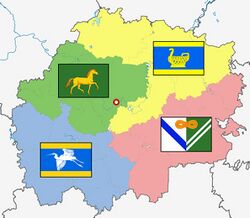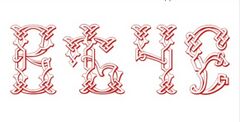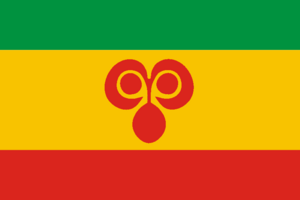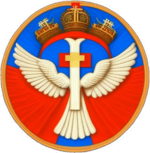Sovæt People's Tsardom of Kaçapia
Sovæt People's Tsardom of Kaçapia Кацапское Совѣтское Народное Царство | |
|---|---|
| Motto: У насъ въ Рѣзани грибы съ глазами | |
| Anthem: Kalinka-Malinka | |
 State Tamga (Mordka) | |
 | |
| Capital | Ræzań |
| Largest city | Horodets |
| Other languages | Kaçapian |
| Demonym(s) | Kaçap |
| Government | Constitutional monarchy with direct democracy |
• Tsar & Grand Duke | Fedor III & IV |
| Legislature | Væche |
| Boyar Douma | |
| Sovæt | |
| Establishment | 1 July 2023 (Republic) 24 July 2023 (Tsardom) |
| Time zone | UTC+3 |
The Sovæt People's Tsardom of Kaçapia (Кацапское Совѣтское Народное Царство), also known as Kaçapia (Кацапія), is a post-Russian state proclaimed within the administrative boundaries of the Ryazan Oblast. It is characterised by external sources as a micronation and historical reconstruction.
Kaçapia is a constitutional monarchy with elements of direct and non-partisan representative democracy, led by Tsar Fedor III & IV. The capital is the city of Ræzań (Рѣzань).
Etymology
The name Kaçapia comes from the Turkish and Crimean Tatar kassap ("butcher, slaughterer"), which in turn is borrowed from the Arabic قَصَّابٌ, qaşşăb. It serves as an ethnophaulism to refer to Russians as Poles, Ukrainians, Siberians and various peoples of the former Russia. There is a version that this meaning comes from the tendency to translate the name of the city of Rězań (from the word рѣзати "to cut"; pronounced "Ryazan" in the local dialect) into Turkic languages. It is probably named after the founder named Rězan ("Circumcised"), and originally, in the XII-XIII centuries, this was not the name of the current centre of the Ryazan region (former Pereyaslavl-of-Ryazan, renamed in 1778 by Catherine II in honour of the capital of the ancient principality), but the princely city destroyed by Batu Khan in the winter of 1237, on the site of which later appeared the village of Staraya Ryazan, which serves as the legal capital of Kaçapia under the name of Ræzań.
History
The Principality of Ryazan (until the middle of the XII century - Murom-Ryazan, from the XIV century - Grand Duchy of Ryazan) for centuries fought for power and dominance on the northeastern periphery of Rus (the so-called "Great Rus"), which, after being destroyed by the Mongols and a period of prosperity in the second half of the XIV century, finally lost in the XVI century to Moscow, ceasing to exist. The proto-ethnicity of the Kaçaps, which was formed in these lands from the Kryvichi Slavs from the west and the indigenous Finno-Ugric peoples of Meshchera and Murom, dissolves in the trends of the new centre of the united Rus'ian lands; the ethnicity of the Great Rusyns (Russians) integrates around Muscovites, descended from the natives of Central Rus (Podniprovia, Ukraine) and the local Finno-Ugric people of the Merya. The glorious past of the Ryazan principality was forgotten and distorted by imperial historiography.
After the events of the spring of 2022, it became clear that the project "Moscow and Muscovites" (renamed "Russia and Russians" after the annexation of the lands of historical Rus in the mi-XVII century, officially in 1721-1918) has suffered a historical collapse and has no future. The micronation of the Sovæt People's Tsardom of Kaçapia, which declared independence on 1 July 2023, was an attempt to revive the Kaçap identity on the remains of the lost Russian one.
Initially, the nation was called the Ryazan People's Republic, but on 24 July it was renamed, with the realisation of both the geopolitical scope of its state ambitions and the greater desirability of a monarchy for the Kaçap mentality.
Politics and government
Monarch
The Grand Duke of Ræzań and Tsar of all Kaçapia is elected by the Boyar Douma from among the Full Yezdetses and Voivodes of the Order of the Red Rooster. This position is for life by Divine right and is not inherited, as the royal charisma is granted through a conciliar election. The Tsar can abdicate, but cannot be removed from the throne by anyone, except in the case of treason against the State Oath, which is considered by the Boyar Douma, which, in the case of a positive verdict, simply confirms that the Tsar is no longer an ontologically Tsar due to the fact of violation of the oath.
On 24 July 2023, Tsar Fedor III & IV (III - among the sovereign Grand Dukes of Ryazan, IV - including Tsar Fedor Ivanovich of Moscow, whose title included "Grand Duke of the Ryazan lands") was elected by the Constituent Assembly, which in this sacred act also changed its essence to the Boyar Douma.
The Tsar is the supreme source of power and sovereignty, as well as the main factor in the principle of the Fusion of powers, since he heads, as the Crown-in-Parliament, both representative Izbas of the legislative branch (but not the Væche, in which he does not participate!), where the Boyar Douma is also the highest judicial authority, and the executive branch - the Hosudar's Cabinet, or Uryad (i.e. the Government).
Legislature
The Kaçap legislative system is characterised by an organic combination of monarchy, representative and direct democracy and has a three-chamber structure.
Væche

The lower house (Izba) of the legislature, called the Væche, provides an opportunity for direct participation of every citizen in the legislative process in three main forms:
- public hearings and discussion of issues;
- legislative initiative by submitting and promoting petitions (chelobitnas) on the government website
- adoption of draft laws by general referendums.
Petition bills must receive at least 5% of the votes of the Tsardom's citizens within a month after being published on the website (for a fee), and a committee of the Sovæt called the Chelobitnas Prikaz must analyse it for compliance with constitutional norms within the same month and, in case of obstacles, inform the Boyar Douma, which may withdraw it from consideration for revision.
The fate of a petition is decided by the percentage of its support from the total number of citizens of the Tsardom:
- >= 5% - put to a vote in the Sovæt;
- >= 33% - submitted to the General Referendum (actually, the Væche), then the same percentages as below;
- > 50% - automatically adopted, the Boyar Douma has the right to veto it:
- > 60% - the Boyar Douma can only postpone the law's entry into force for up to six months;
- >= 75% - only the Tsar can postpone the law for up to three months.
Issues related to changes in the political system, borders, and foreign policy vector are resolved exclusively by general referendums, but are initiated exclusively by the Boyar Douma, and must receive at least 75% of the Sovæt's vote to be put to a referendum.
Sovæt

The Sovæt is the middle house (Izba) of the Kaçap legislation. The name means literally "Council", but also "with the Væche", "accompanying the Væche". It is composed of elected mayors of cities and counties (or more often their delegated proxies), delegates from regional zemstvos, and political party leaders. This ensures the principle of democratic centralism: bottom-up election and top-down accountability. Since all the positions that form the membership are elected and have limited terms, there is no need for general direct elections to the Sovæt. Its membership is also renewed dynamically and on a rotational basis. Zemstvos can replace their delegates and mayors and county governors can replace their proxies at any time, including at the request of the population they represent.
The general requirements for the positions that make up the Sovæt exclude boyars, civil servants (dyaks of the Hosudar) and people with certain legal or health problems.
The Sovæt is officially a plenipotentiary branch of the Væche, acting on its behalf between referendums, providing an intermediate link between the people and the Tsar and the Boyar Douma. In fact, it is responsible for drafting and adopting secondary laws and bylaws, as well as for resolving issues that are the exclusive prerogative of the Sovæt (budgeting, etc.).
The Sovæt's meetings are chaired by the Supervisor (Nadzorny), who is not a member of the Sovæt. He is appointed by the Tsar from among the Children of the Boyars, remaining a member of the Douma with an advisory vote, and is included in the Government as the Sovæt's Okolnichy. This ensures contact and interaction between the branches of government. The Nadzorny has two assistants and deputies (tovarishches) in the Sovæt, with whom he forms the Presidium of the Sovæt. The Nadzorny's tovarishches are the first two to receive votes in the ranked voting for these positions, but the Nadzorny chooses which of them will be first. If there is one vacancy, he can choose one candidate from two new ones, or he can take both of them instead of the remaining tovarishch.
The Boyar Douma can veto laws passed by less than ¾ of the Sovæt's votes, but only if a greater percentage of the boyars vote in favour of the decision than the percentage of the Sovæt's public in favour of it. Otherwise, the law's entry into force was simply postponed for six months. To override the veto of the Sovæt, a higher percentage of votes than the vetoed one would have to be obtained during the re-vote. In addition, the Douma can postpone any law passed by the Sovæt for up to six months, and the Tsar on his own behalf can postpone it for up to three months, adding his own term to the one imposed by the Douma.
Boyar Douma

The Boyar Douma is the highest and elite house (Izba) of the Kaçapian legislation. It is not aristocratic but meritocratic in nature, as boyarism is granted only to individuals with the degree of Dostoynik of the Order of the Red Rooster and is not inherited. However, the children of the boyars have the privilege of sitting in the Douma in an advisory capacity after they have attained the rank of Yezdets of the Red Rooster.
Douma meetings are chaired directly by the Tsar or, if he is unable to attend, by his appointed representatives. As speeches in the Sovæt are addressed to the Nadzorny, who chairs it on behalf of the Tsar, so speeches in the Boyar Douma are addressed to the Tsar or his Representative. The Tsar acts in the Douma as the sovereign source of supreme power, but accepts its decisions (Royal assent) as a manifestation of the conciliar spirit of the nation (Sobornost), from which he himself received his anointing.
The legislative functions of the Boyar Douma are expressed in
- drafting bills that are submitted for adoption by the Sovæt or (if they relate to reforms of the state system) the Væche. Bills initiated by the Douma go to the Tsar for signature immediately after adoption by the lower house;
- approval of bills passed by the lower chambers with a veto (if less than 60% of the votes of the Væche or less than 75% of the votes of the Sovæt, and the percentage of votes of the Douma in favour of the veto is higher) or postponement for up to six months.
The Douma independently adopts laws concerning court ceremonial and approves candidates for state awards.
The Boyar Douma also has judicial powers - as the highest court of appeal and as a body with the exclusive right to try boyars accused of a serious criminal offence or treason. Its judgements are regarded as precedents at the level of law. The Chancellery Committee (Douma's Prikaz) performs the functions of the Constitutional Court.
In the event of the Tsar's death or abdication, the Boyar Douma elects a new Tsar from among the Full Yezdetses and Voivodes of the Order of the Red Rooster.
Political parties
Since the Sovæt is formed on a non-partisan basis, political parties are involved in the election campaign only indirectly, at the level of organised promotion and support by their members and supporters of "their" candidates for office, who are ex officio members (glasnies) of the Sovæt. The only advantage over non-party political movements is that if a party is included in the State Register (has received the Tsar's Yarlyk) and its members are represented in the Sovæt, its leader also holds a seat in the Sovæt, and if his party gains a relative majority over others, he becomes the Tsar's Sovæt Counselor and participates in the formation of the Cabinet. Party leaders lose their seats in the Sovæt if their members are not represented there for a year and are reinstated with them.
In order to be included in the Register, a candidate movement for the status of a political party must have branches in all counties and submit a petition for recognition to the Tsar, which he considers together with the Boyar Douma and makes a decision. Registration may be withdrawn if the Tsar and the Douma consider the party's activities to be destructive and harmful to the state.
Currently, three parties are represented in the Sovæt:
Executive
The Hosudar's Cabinet is formed by the Tsar on his own, with optional consideration of nominations from the Sovæt Counselor, who is automatically the leader of the political party holding the majority of seats in the Sovæt (taking into account the party affiliation of mayors and county heads, but not their proxies in the Sovæt, who can be either their fellow party members or non-partisans, but not members of other parties). Since the Sovæt are not formed on a party basis and are renewed on a rotational and gradual basis, the Sovæt Counselor, which expresses the voice and will of the people, can change very suddenly, and the Tsar has no control over this process.

The members of the Cabinet are called Okolnichies and head the Prikazes (ministries), that make up the Uryad in the broadest sense. The employees of the Prikazes are called the dyaks (i.e. clerks) of the Prikaz or, in general, the uryadniks (government officials). The Cabinet also includes the Sovæt's Nadzorny (also known as the Sovæt Okolnichy), which thus not only represents the Tsar in the Sovæt but also ensures its connection with the Douma (of which he is always a member as a Boyar's Child) and the Cabinet. Boyars and members of the Sovæt could not be appointed as Okolnichies, but Boyar's Children (of whom the Cabinet in practice largely consists) could.
Since the Okolnichies are appointed by the Tsar, they report only to him, but at meetings of the Boyar Douma. At the Sovæt, the reports of the Okolnichies are read out by the Nadzorny, after which, as in the Douma, the failure to perform can be discussed and assessed on his Prikaz work. The Tsar may dismiss the Okolnichies at his discretion (including taking into account the assessment of their performance by the representative Izbas), but only after the end of the reporting period and the reading of the report, and before appointing a new one, he must consult with the Sovæt Counselor on the candidates.
Both the Boyar Douma and the Sovæt can initiate the resignation of the Hosudar's Cabinet after a year of its work. In the Douma, the prior consent of at least three boyars is required to put the issue to a vote, while in the Sovaet, the consent of the Sovæt's Counselor is required. If the Izba voted in favour of the resignation by at least ¾ of the votes, the question was passed to the other Izba, which also had to support it by at least 75%. Only then was the Tsar obliged to dissolve the Uryad. On his own initiative, he can do so after a year of work without preconditions, but the Boyar Douma has the power to postpone the dissolution for up to six months.
Zemstvos and magistrates
The principle of Fusion of powers (or, more precisely, their coordination), to an even greater extent than in the central state bodies of the Tsardom of Kaçapia, works at the level of local self-government. Power at the local level is exercised by elected bodies (zemstvo councils in counties and city councils in cities), whose representatives (glasnies) are elected by direct suffrage for three years. The accountable committees established by the councils and the public organisations and initiative groups grouped around them form zemstvos (in cities - magistrates).
Glasnies reports to voters every six months, and after a year in office, they can be recalled by voters early with new elections in a given constituency (the principle of an Imperative mandate).
The accountable committees of zemstvo and city councils include the executive committee (Uprava) and the zemstvo or magistrate court. The relative independence of the branches of government under this system is controlled by the Tsar's appointee for the county and its centre, the Namæstnik, a member of the Boyar Douma, who considers complaints about abuse and usurpation of authority. He also acts as a coordinator between the zemstvo and the magistrate.
Administrative regions
On 1 October 2023, the administrative-territorial reform of the Tsardom of Kaçapia came into force, approving the boundaries of the counties - the spheres of influence of the county towns. Currently, there are four counties:
| County | Flag | Coat of Arms | Administrative centre |
|---|---|---|---|
| Pereyaslavsky | 
|

|
Pereyaslav |
| Horodetsky | 
|

|
Horodets |
| Chaplinsky | 
|

|
Chaplin |
| Saxovsky | 
|

|
Saxovo |
With the development of the nation, the counties are likely to be further fragmented, but now they are restructuring their volosts based on economic and social ties.
Geography and climate
In terms of physical geography, Tsardom of Kaçapia lies in the central part of the East European Plain between the Central Russian and Volga uplands. The terrain is flat, with the highest point of no more than 300 m above sea level. Soils are podzolic and boggy on the left bank of the Oka, changing southward to more fertile podzolic and leached black-earths (chernozyom).
The climate is moderately continental. The average temperature in January is -10.6 °С, in July +19.7 °С. Precipitation is about 550 mm per year, maximum in summer, 25-30 % of all precipitation falls as snow. The vegetation period lasts about 180 days.
| Climate data for Ræzań (1871–2023) | |||||||||||||
|---|---|---|---|---|---|---|---|---|---|---|---|---|---|
| Month | Jan | Feb | Mar | Apr | May | Jun | Jul | Aug | Sep | Oct | Nov | Dec | Year |
| Record high °C (°F) | 6.3 (43.3) |
7.5 (45.5) |
17.8 (64) |
29.0 (84.2) |
33.5 (92.3) |
36.7 (98.1) |
38.9 (102) |
39.5 (103.1) |
33.0 (91.4) |
24.2 (75.6) |
15.8 (60.4) |
8.9 (48) |
39.5 (103.1) |
| Average high °C (°F) | -4.5 (23.9) |
-3.7 (25.3) |
2.0 (35.6) |
12.1 (53.8) |
20.4 (68.7) |
23.4 (74.1) |
25.6 (78.1) |
24.0 (75.2) |
17.6 (63.7) |
9.5 (49.1) |
1.4 (34.5) |
-3.0 (26.6) |
10.4 (50.7) |
| Daily mean °C (°F) | -7.4 (18.7) |
-7.1 (19.2) |
-1.8 (28.8) |
6.8 (44.2) |
14.0 (57.2) |
17.4 (63.3) |
19.6 (67.3) |
17.7 (63.9) |
12.2 (54) |
5.8 (42.4) |
-1.1 (30) |
-5.4 (22.3) |
5.9 (42.6) |
| Average low °C (°F) | -10.1 (13.8) |
-10.2 (13.6) |
-5.2 (22.6) |
2.4 (36.3) |
8.4 (47.1) |
11.9 (53.4) |
14.2 (57.6) |
12.5 (54.5) |
8.0 (46.4) |
2.8 (37) |
-3.2 (26.2) |
-8.0 (17.6) |
2.0 (35.6) |
| Record low °C (°F) | -40.9 (-41.6) |
-34.8 (-30.6) |
-28.6 (-19.5) |
-18.6 (-1.5) |
-5.0 (23) |
-1.8 (28.8) |
3.5 (38.3) |
0.4 (32.7) |
-7.3 (18.9) |
-14.6 (5.7) |
-24.5 (-12.1) |
-39.7 (-39.5) |
−40.9 (−41.6) |
| Average Precipitation mm (inches) | 40 (1.57) |
37 (1.46) |
32 (1.26) |
41 (1.61) |
40 (1.57) |
64 (2.52) |
78 (3.07) |
55 (2.17) |
51 (2.01) |
61 (2.4) |
46 (1.81) |
48 (1.89) |
593 (23.35) |
| Average relative humidity (%) | 85 | 82 | 76 | 67 | 61 | 70 | 72 | 74 | 77 | 82 | 86 | 85 | 76 |
| Average rainy days | 4 | 4 | 5 | 11 | 13 | 15 | 14 | 13 | 14 | 15 | 11 | 5 | 124 |
| Average snowy days | 23 | 20 | 13 | 4 | 1 | 0 | 0 | 0 | 0.4 | 4 | 14 | 22 | 101 |
| [citation needed] | |||||||||||||
Culture
The culture of Kaçapia is characterised as a reconstruction of the heritage of the Grand Duchy of Ryazan, cleansed of historical assimilation by Moscow influence. It is formed by the equal and consensual interaction of ancient Rusyn and Finno-Ugric ethnic cultures.
National symbols

The tamga-mordka first appears on coins circulating in the Ryazan principality from around the 1390s during the reign of Prince Oleh Ivanovich (overprinted on the coins of the Jochi Ulus). During the reign of Prince Ivan Fedorovich, his own coin was minted with the same sign, which, therefore, from the personal seal of a particular prince, became a symbol of the dynasty, in accordance with the new European heraldry.
The tamga is probably a development of the princely sign (two-tooth / trident) of the Kyivan princes (Rurikids). It resembles the head of a ram or the face of a marten - hence its historical folk name "mordka" (small animal face, muzzle). However, today in the Kaçap Tsardom it is more often interpreted as a mushroom with eyes, which refers to the saying "We have mushrooms with eyes in Ryazan - you eat them, but they look" ("У нас в Рязани / грибы с глазами: / их ядять, / а они глядять"; perhaps a reference to the speckled fly agaric, which Kaçaps traditionally use for its narcotic effect).
The outlined or painted image of the State Tamga and the red Tamga on a golden shield (the Lesser Coat of Arms) are completely synonymous and interchangeable state symbols.

The flag of Kaçapia is a rectangular panel with a width to length ratio of 2:3, consisting of three horizontal stripes - green, yellow and red, in the ratio of 1:2:1. On the front side of the flag of the Kaçap Sovæt People's Tsardom, in the centre of the middle yellow stripe, is the red State Tamga.
The three horizontal stripes of the flag denote the hierarchical three-chamber legislature of the Tsargdom (Væche - Sovæt - Boyar Douma), and its symbolism reproduces the traditional Kaçap national colours:
- Yellow (gold) symbolises wealth, justice, generosity, and in Orthodox iconography, eternity and divinity.
- Green is the colour of supreme power, life and renewal, and in Christian interpretation, spirituality and holiness.
- Red represents the courage, bravery and sacrifice of the Kaçap people.

The Greater Coat of Arms of the Tsardom of Kaçapia is used only by the Tsar and the Boyar Douma, as well as by embassies abroad and on diplomatic passports. The shield is surrounded by the chain of the Full Yezdets of the Red Rooster and is crowned with the hat of the Grand Duke of Ræzań and Tsar of all Kaçapia.
The shield is supported by the national animals of the Kaçaps - a Swine and a Hound. The pig, a traditional symbol of the Kaçap people, represents courage and fearlessness, while the dog represents loyalty, devotion and vigilance. The combination of these Kaçap qualities is signified by the mythological figure of the SwineHound, borrowed during the period of Mongol rule. Mongolian sources avoid describing it as "something that has no name and no image". Judging by the Chinese name 皮解麒 (Píjiě Qí), it resembled a qilin without skin; also, according to some legends, it has five legs (but perhaps the fifth leg is not a leg). The ancient Kaçap name Sobaka-Barabaka indicates that it was originally imagined in Rus' as a chimera of a dog and a ram. Therefore, perhaps the Ryazan Tamga-mordka is a schematic representation of its head. But later it was combined with the national Kaçap symbol, a pig.
Languages
The official languages of the Kingdom are Kaçapian (codified on the basis of Ryazan dialects), Erzya, Tatar Kasym-Bastan and Mishar (two separate standards), as well as reconstructed Muromian, Meshchera (Finno-Ugric) and Galindian (Baltic).




